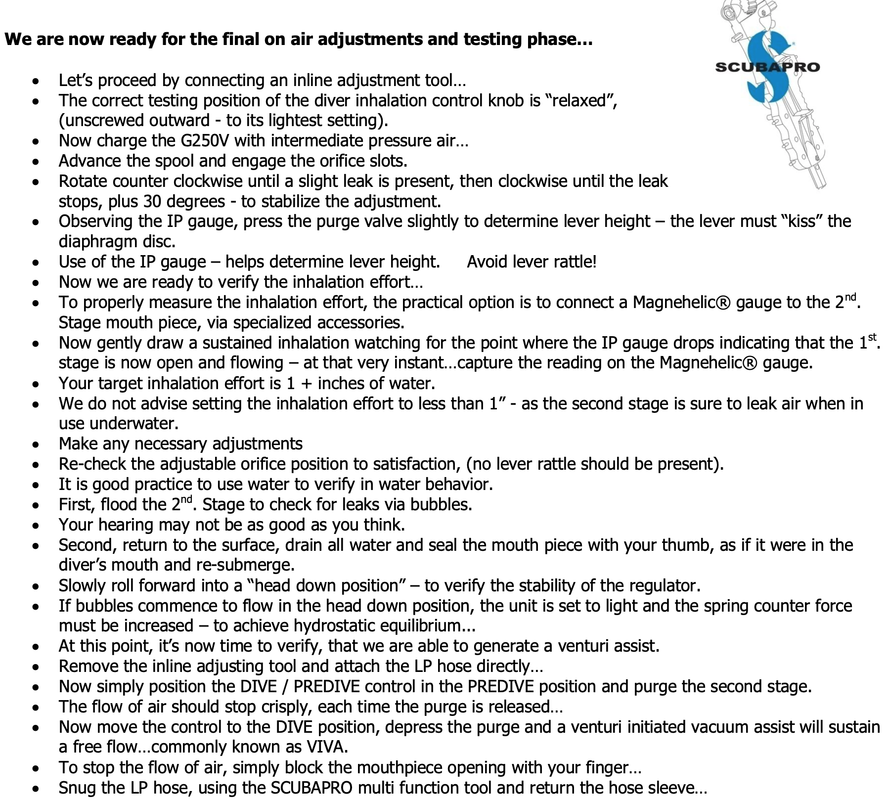This thread has a lot of misinformation or at least some confusion.
Most modern regulator second stages have two external controls. One is the Venturi usually indicated as Dive/Pre-dive or Max/Min. The second control is usually a knob that controls spring tension, the force applied to the seat upon the orifice when static. Atomic regulators have an automatic Venturi control so they only have the seat tension adjustment.
A second stage properly adjusted to any service manual should not free flow or leak just sitting there.*
With the second stage tension knob fully out and the Venturi in DIVE/Max pressing and then releasing the purge should cause a sustained free flow.
With the second stage Venturi set to pre-Dive/Min the regulator should stop flowing when the purge is released.
Here is the Scubapro instruction for function check in the G250 Service Manual, note the last few bullets. This is typical. Not all SMs use the same wording or description but the intent is essentially the same:

In all cases there is a SM provided cracking effort specification, for example the SM will say that the second stage should begin to flow with 1.1 to 1.6 inches of water column with the knob if present fully turned out. The excerpt from the G250 SM is an example, the specific range for cracking effort to initiate flow may vary for a specific second stage model/brand as may the procedure for checking.
When serviced it is often needed to set the cracking effort/orifice adjustment a little to the high side (but still within specification) so that when the seat breaks in to the orifice, it will not ever so slightly leak (or leak annoyingly

) which will then cause a service return and an upset customer.
(*)Some divers, do in fact set up there personal second stages to ever so slightly leak (not free flow) with the tension knob fully out. I set mine up that way but I would not have for a customer reg. If turning the knob in about a half turn to a full turn does not stop the leak (not free flow) then I make an adjustment to make it so for my personal regulators. Usually a minor orifice adjustment.
(**)Some second stages do not have a Venturi control nor a spring/seat tension knob. An example of a well known second stage many still use commonly is the USD/AL 1085 (Conshelf). In such case the primary should be set to have a sustained free flow when the purge is released and the secondary should be set to stop free flowing when the purge is released. For cold water use, especially those without adjustments, should be set to not free flow when the purge is released. Most SM will show a higher cracking effort range and a lower IP for cold water specific regulators.
In other words regulators should be set per their SM instructions unless you as a diver have the specific knowledge, reasons and tools to do otherwise. Most do not.
And one final thing, there is a widely believed idea that setting the tension knob in (higher cracking effort) or setting the Venturi knob towards Min/Pre-dive will conserve air. No, no, no. This will only cause CO2 increase, higher air consumption not lower because the diver must work harder to ventilate, give the diver a head ache and can be quite dangerous. So why even have the tension knob you ask? It has a use, an example would be if scootering or swimming into a current, the force of the water rushing upon the second stage diaphragm will cause free flows and the diver can usually inhibit that by turning the knob inward to increase tension. Another, a working diver or a photo diver may have to be in a head down position for a lengthy time, this position, head down, may cause a well tuned regulator to free flow, the diver can turn the knob inward to reduce the tendency to free flow.




